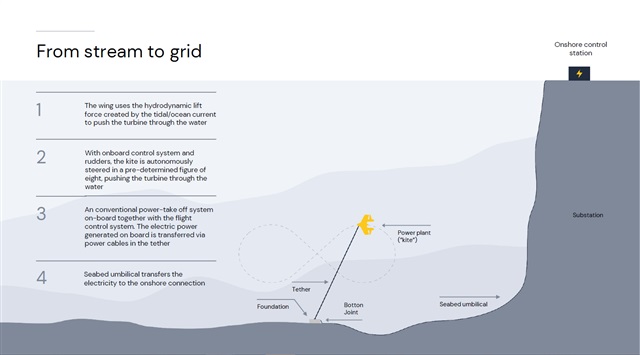The most valuable unexploited natural resource on earth? Tidal streams and ocean currents might be the answer.
A spin-off from Swedish aerospace manufacturer Saab, Minesto utilizes an underwater kite tethered to the seabed. The kite captures the lifting force from ocean currents, allowing for a controlled trajectory in the shape of an eight, multiplying the water current flow through the onboard turbine.
In consideration of the current state of the global energy crisis, a significant determinant for the future emerges. The ability to generate energy domestically is pivotal, offering a secure supply and establishing it as a self-controlled and dependable resource.
"Why do we come to Taiwan? If you have a similar natural resource in the ocean currents that sweep the coast of the east and then the tides that you have north and in the Taiwan Straits, it's an enormous amount of energy that will be there forever."

Credit: Minesto
Martin Edlund, CEO of Minesto, highlighted the parallels between Taiwan and Sweden in harnessing renewable energy sources that can provide sustainable power indefinitely. Drawing on Sweden's historical use of river currents for hydropower, Edlund emphasized the potential of ocean currents and tides along Taiwan's coast, presenting an enormous and perpetual energy resource.
Minesto has successfully demonstrated its 100-kW tidal kite in the Faroe Islands, generating electricity at high performance. The company aims to develop large underwater arrays, with systems ranging from 1.2MW and upwards. Edlund stressed the importance of low weight, highlighting that their 1.2MW device is only around 28 tons, contributing to reduced installation and operating costs.
In Southeast Asia and the Asia-Pacific region, there is a visible presence that provides the company with hundreds of gigawatts of installed capacity. "We can do this both small scale with microgrids, or smaller islands where there is no sort of big grid connection. That's also why we are active at an early phase in large island nations such as Indonesia and the Philippines."
Edlund expressed Minesto's commitment to working with Taiwanese partners for manufacturing and project development. This unique technology is tailored to address ocean currents and tidal flows in Taiwan. Minesto's collaboration with TCC Green Energy for the project involves the demo site selection and investigation phase.
"We're working with TCC Green Energy. We have collaborations with the National Taiwan Ocean University(NTOU) in Keelung, north of Taiwan. But we're inviting more actors to join us. Also, we have additional discussions with ITRI on some more technological diversifications."
Minesto urged the retention of feed-in tariffs, emphasizing their role in attracting long-term investments and making Taiwan a global player in ocean energy. Edlund also highlighted the potential for collaboration between Taiwanese and European/Nordic companies to enhance technology and reduce carbon footprint through local manufacturing.
However, Minesto's deployment in Taiwanese waters presents various challenges. The company emphasized the critical role of the Taiwanese government in providing essential support for the ocean energy project. The discussion touched on the challenges of subsea cable costs and the varying results obtained by different units conducting marine studies.
To select suitable areas for development, emphasis was placed on the importance of reliable seabed data, which the government is expected to provide. Additionally, Minesto elaborated on ongoing interactions with the National Academy of Marine Research, exploring potential collaboration in resource surveys.




